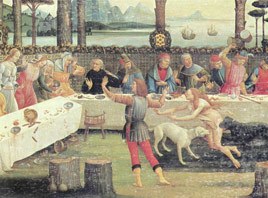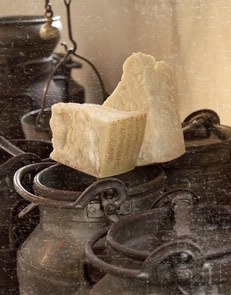Parmesan Cheese Origin
There are many misconceptions about the word Parmesan, but there is no doubt whatsoever about Parmesan cheese’s origin! Parmesan refers to the famous cheese made in and around the Italian province of Parma for the past eight centuries and more. Historically speaking, it is an earlier term for what we now call Parmigiano Reggiano® cheese.
The history of Parmesan cheese and its etymology are fascinating, so let’s go back a few centuries and trace them.
Early Parmesan Cheese History
The concept of naming foods after their place of origin dates back to the Roman Empire. Even after the fall of Rome in 476 A.D., people on the Italian peninsula continued to follow that practice. It was a convenient way to describe the food, but also showed pride in its making.
It was monks in the area around Parma who first started making a distinctive hard cheese during the Middle Ages. By the time of the Renaissance, people in the nobility were producing this fine cheese for their own tables. It was known as caseum paramensis in Latin, and locals shortened this to Pramsàn, in dialect.
Parmesan Makes a Name for Itself
 By the early 14th century, Parmesan cheese had traveled from its place of origin in the Parma-Reggio region over the mountains to Tuscany, where ships departing from Pisa and Livorno carried it to other Mediterranean ports. The first recorded reference to Parmesan, in 1254, documents that a noble woman from Genoa traded her house for the guarantee of an annual supply of 53 pounds of cheese produced in Parma.
By the early 14th century, Parmesan cheese had traveled from its place of origin in the Parma-Reggio region over the mountains to Tuscany, where ships departing from Pisa and Livorno carried it to other Mediterranean ports. The first recorded reference to Parmesan, in 1254, documents that a noble woman from Genoa traded her house for the guarantee of an annual supply of 53 pounds of cheese produced in Parma.
History immortalized the use of Parmesan cheese as a condiment for pasta in Boccaccio’s Decameron tale about an imaginary gourmet paradise called Bengodi. At the summit of a delightful mountain of Parmesan, cooks rolled macaroni downhill to acquire a coating of the snowy cheese.
Parmesan: the French Connection
By the 1530s, Italian nobles began to refer to the cheese as Parmesano, meaning “of or from Parma.”
Given the close ties between the Italian and French nobility, it’s no surprise that the name was shortened to Parmesan in the French courts of the day. The latter acquired a taste for the cheese they often received as a gift from Parma visitors. Another name indicating the Gallic appreciation for this cheese was fromage de Parme.
The Name Parmesan Stuck!
From the 17th to the 19th centuries, the name Parmesan became more common due to the continuing close relations between the Dukes of Parma and the French nobility.
Seeking to prolong his life, the playwright Molière decided to live on a diet consisting of 12 ounces of Parmesan and three glasses of port a day. His fad diet had merit from a nutritional standpoint because Parmigiano Reggiano is rich in protein and easy to digest.
According to historical records mentioning the cheese, the name Parmesan eventually spread beyond France to take root in other countries.
Italian Terms for Parmesan
If the French word Parmesan means “of or from Parma,” what does Parmigiano mean? The same thing, in Italian. Producers who lived closer to Reggio than to Parma might refer to their cheese as Reggiano. These Italian terms indicating geographical origin became common only in the 19th and 20th centuries with the political and linguistic unification of Italy.
In 1934, producers in Parma and Reggio-Emilia joined forces with producers in the provinces of Modena and Mantua (the portion to the east of the Po River) to form an association called the Consorzio del Grana Tipico. Recognizing that they shared the same cheese-making terroir, these cheese makers banded together to standardize the production of their cheeses. Producers from the province of Bologna (to the west of the Reno River) later joined the group.
It’s Official: Parmigiano Reggiano
 In 1954, the pioneering alliance of cheese makers renamed their group the Consorzio del Formaggio Parmigiano-Reggiano. In choosing this name, members acknowledged the historic role played by Parma and Reggio producers in defining the character of the cheese and the methods for making it properly.
In 1954, the pioneering alliance of cheese makers renamed their group the Consorzio del Formaggio Parmigiano-Reggiano. In choosing this name, members acknowledged the historic role played by Parma and Reggio producers in defining the character of the cheese and the methods for making it properly.
From that point on, the official name of the cheese has been Parmigiano Reggiano, as indicated by the pin dots imprinted on the rind of each wheel. Members of the Consorzio not only follow strict production standards, but they work together to market Parmigiano Reggiano and protect the name from imitators.
Parmigiano Reggiano, the Only Parmesan
In 2008, European courts decreed that Parmigiano Reggiano is the only hard cheese that can legally be called Parmesan. In so doing, they acknowledged the historical fact that the word can be traced to Parma and that consumers associate the cheese with its origin in the Parma-Reggio region of Italy. These court rulings mean that a cheese cannot be called Parmesan unless it conforms to the Protected Designation of Origin (PDO) standards for Parmigiano Reggiano.
While these laws are enforced in Europe, elsewhere in the world there are many would- be imitators. To avoid misunderstandings, the consortium of Parmigiano Reggiano producers encourages retailers and consumers in the U.S. and other countries to understand the history of Parmesan and to use the cheese’s correct name: Parmigiano Reggiano.